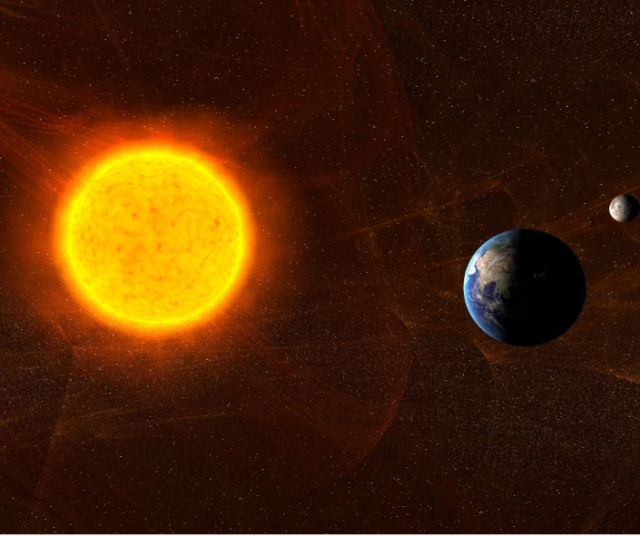The connection between the Moon and the sea has fascinated humanity for centuries, inspiring myths, poetry and deep reflection on the cosmic interaction that shapes our planet. From imposing tides to nights illuminated by silver light, the relationship between the Moon and the sea is a celestial poem that awakens the imagination and admiration.
History and Mythology: The Moon as Goddess of the Sea
In the mythologies of various cultures, the Moon is often personified as a deity associated with the sea, weaving a mystical story that reflects the profound influence of these two elements on human consciousness.
In Greek mythology, the lunar goddess Selene emerges as a central figure in this celestial narrative. Selene, considered the personification of the Moon, was revered for her nocturnal splendor and her connection to the sea. Her romantic history with Endymion, a mortal, adds layers of complexity to her relationship with the underworld. The nights of the full moon were considered moments of union between Selene and Endymion, representing the fusion between the firmament and the earth.
Additionally, in Roman mythology, the lunar goddess Diana shared similarities with Selene, and both deities were linked to the ocean and its tides. The idea that the Moon, with its silvery light, guides the waters of the sea in its tides, inspired both reverence and awe in these ancient cultures.
In Hindu mythology, Chandra, the moon god, also had a special relationship with the sea through his connection with the goddess Ganga, the personification of the sacred river Ganges. This association symbolizes the idea that the Moon, by controlling the tides, influences the purity and fluidity of the waters.
This mystical legacy has transcended the ages, influencing poetry, art, and traditions around the world. The image of the Moon as a sea deity endures, reminding us that, even on the darkest nights, the lunar light continues to illuminate the vastness of the ocean, creating a spiritual link between the two cosmic realms. The connection between the Moon and the sea is not only manifested in the tides, but also in the stories and myths that have woven a rich tapestry of understanding and wonder throughout human history.
Gravitational Power: Tides and Tidal Waves

The physical relationship between the Moon and the sea is manifested through the phenomenon of tides. The gravitational pull of the Moon on the Earth, along with that of the Sun to a lesser extent, causes the periodic rise and fall of sea levels. During the full moon and new moon, when the Earth, Moon and Sun are aligned, the tides are more pronounced, creating what we know as high tides or high tides.
This phenomenon is also responsible for spring tides, in which the tides are especially high due to the close alignment of the Earth, Moon, and Sun. Although tides are primarily caused by the Moon, the Sun also contributes significantly to this. heavenly dance
The Silver Light: Nights of Enchantment and Mystery
The light of the Moon over the sea creates a unique night landscape that has inspired countless poems, songs and works of art. The surface of the ocean is illuminated with silvery sparkles, while the waves shine like liquid jewels under the luminous embrace of the Moon. This visual connection between the Moon and the sea has been a source of inspiration for those seeking serenity and contemplation on quiet nights.
Lunar Rhythm and Sea Cycles: A Celestial Compass
The Moon also influences the biological cycles of many marine species. Some species of sea turtles, for example, follow the lunar cycle to nest on the beach. In addition, various marine organisms take advantage of the tides for reproduction and feeding. The relationship between the lunar cycle and behavioral patterns at sea is a reminder of the intricate web of connections between celestial bodies and life on Earth.
Artistic and Literary Inspiration: Poems of the Moon and the Sea
From Shakespeare's verses in "The Tempest" to contemporary song lyrics, the relationship between the Moon and the sea has inspired artists throughout history. The duality of the soft light of the Moon and the mysterious vastness of the ocean has been a recurring metaphor in poetry, symbolizing the duality of human nature and the connection between the deepest elements of existence.
Lunar Cultures and Celebrations at Sea: Full Moon over the Waves
Various cultures have celebrated rituals and festivals that honor the connection between the Moon and the sea. In some coastal communities, full moon nights are special occasions for ceremonies, music and dance that express reverence for this cosmic relationship. These celebrations often capture the poetic essence of the Moon and the sea as dancing partners in the vastness of the sky and ocean.
Emotional Reflections: The Moon as a Witness to the Tides of the Heart
In romantic literature, the Moon has often been personified as a witness to lost loves, passionate encounters, and fleeting emotions. Its soft, constant light is associated with stability amid the tumultuous tides of the human heart. Thus, the Moon and the sea share a shared symbolism in narratives of love and loss.
Space Exploration: The Moon as a Starting Point
Space exploration has taken humans beyond the terrestrial sphere, but the Moon remains an important reference point. Lunar missions have provided valuable information about the formation of the solar system and the history of Earth. The Moon, with its unique relationship with the sea, has been a source of inspiration for exploring and understanding the mysteries of the cosmos.
The relationship between the Moon and the sea is an eternal dance that has endured throughout the centuries. From the mysteries of the tide to romantic poetry, the Moon and the sea continue to be protagonists in human narrative. Beyond its physical impact on Earth, this connection transcends the scientific and becomes a poetic symbol of interconnectedness and harmony in the vast scene of the cosmos.






